INSTITUT SUPERIEUR D'ANTHROPOLOGIE
INSTITUTE OF ANTHROPOLOGY
ONLINE COURSES / COURS A DISTANCE
SUMMER TERM : JULY 2013
REGISTER NOW
ROYAUME UNI – 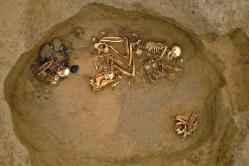 Cliffs End Farm - Britain was a nation of immigrants long before multiculturalism was invented, according to a study of Bronze Age residents of Kent. A burial site at Cliffs End Farm, near Pegwell Bay, contained the remains of more than two dozen individuals who lived in Britain about 3,000 years ago. But what has astonished archaeologists is that as well as people who grew up locally, a series of burial pits contained the remains of immigrants from as far afield as Scandinavia and the western Mediterranean.
Cliffs End Farm - Britain was a nation of immigrants long before multiculturalism was invented, according to a study of Bronze Age residents of Kent. A burial site at Cliffs End Farm, near Pegwell Bay, contained the remains of more than two dozen individuals who lived in Britain about 3,000 years ago. But what has astonished archaeologists is that as well as people who grew up locally, a series of burial pits contained the remains of immigrants from as far afield as Scandinavia and the western Mediterranean.
http://www.thetimes.co.uk/tto/science/archaeology/article3782800.ece?CMP=OTH-gnws-standard-2013_06_05
CHINE – Pamirs plateau - Chinese archaeologists have started excavating a cluster of tombs on the Pamirs Plateau that are arranged to imply sun worshipping. The tombs were found in Xinjiang's Taxkorgan Tajik Autonomous County, a border region neighboring Afghanistan and Pakistan in 2007, and the arrangement is a new mystery on the crossroads of the ancient Silk Road. Eights tombs, each two meters in diameter, were arranged on a 100-meter-long and 50-meter-wide platform, with lines of black stones and lines of white stones stretching alongside like sun rays, according to the archaeology team with the Chinese Academy of Social Sciences. Carbon dating results showed that the tombs date back about 2,500 years, or 300 years before China's first emperor established the Qin Dynasty (221-207 BC). "The ray-like stone strings might imply sun worship. No similar ones have been detected before in all of Central Asia," team captain Wu Xinhua said. He added that the discovery illustrates a gap between their knowledge and studies, and previous findings about the history of sun worshipping culture in the Eurasian hinterland. Dilsadiq, head of the county's cultural relics department, said that the people buried in the tombs might have dignified social statuses because the black stones carried from afar and lined up with a certain pattern were a rare resource in the area. Three similar but smaller tomb clusters with ray-like stones have also been discovered in the county.
http://news.xinhuanet.com/english/china/2013-06/04/c_132430533.htm
USA – 
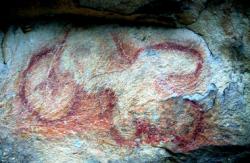 Alabama – North Alabama is in danger of losing two hidden and historic gems: A log house built 200 years ago in Madison County and a little-known gallery of cliff art created more than 600 years ago in Marshall County. The Urquhart house, built in 1813 and located near Toney, and Painted Bluff above the Tennessee River are listed on this year's Places in Peril, which calls attention to historical sites in danger of being lost to aging, weather or human carelessness. The list is released by the Alabama Historical Commission and the Alabama Trust for Historic Preservation. High above the Tennessee River, 80 colorful drawings called pictographs decorate Painted Bluff. The Marshall County cliff is one of the few remaining painted bluffs in the state because of weather and human carelessness. The Tennessee Valley Authority manages the site and its archaeologists are searching for ways to protect it. Although its exact age is unknown, a burned river cane torch discovered at the site was carbon dated to 1400 AD, which archaeologists believe to have been left at the site during the period when the drawings were made. The drawings include anthropomorphic human figures as well as fish, snakes and other animals. Pritchard said the pictographs are endangered by weather but "they are also endangered by human activity. A lot of spray painting and graffiti goes on along this bluff, as well as rock climbing."
Alabama – North Alabama is in danger of losing two hidden and historic gems: A log house built 200 years ago in Madison County and a little-known gallery of cliff art created more than 600 years ago in Marshall County. The Urquhart house, built in 1813 and located near Toney, and Painted Bluff above the Tennessee River are listed on this year's Places in Peril, which calls attention to historical sites in danger of being lost to aging, weather or human carelessness. The list is released by the Alabama Historical Commission and the Alabama Trust for Historic Preservation. High above the Tennessee River, 80 colorful drawings called pictographs decorate Painted Bluff. The Marshall County cliff is one of the few remaining painted bluffs in the state because of weather and human carelessness. The Tennessee Valley Authority manages the site and its archaeologists are searching for ways to protect it. Although its exact age is unknown, a burned river cane torch discovered at the site was carbon dated to 1400 AD, which archaeologists believe to have been left at the site during the period when the drawings were made. The drawings include anthropomorphic human figures as well as fish, snakes and other animals. Pritchard said the pictographs are endangered by weather but "they are also endangered by human activity. A lot of spray painting and graffiti goes on along this bluff, as well as rock climbing."
http://blog.al.com/breaking/2013/06/600-year-old_cliff_drawings_20.html
USA - 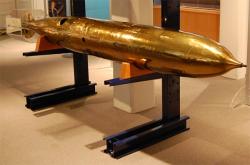 Coronado - Unlike Acoustic Kitty, the U.S. military's dolphin program, active since the 1960s, has had quite a bit of success. Dolphins, you see, are capable of producing sonar, and have an aptitude for learning commands, proving to be much more useful than machines for aquatic mine detection. "Dolphins naturally possess the most sophisticated sonar known to man," explains Braden Duryee, operations supervisor for the SSC Pacific Biosciences Division. "They can detect mines and other potentially dangerous objects on the ocean floor that are acoustically difficult targets to detect." This time, though, two of the trained bottle-nose dolphins have discovered something much more interesting than mines off the coast of Coronado, Calif: a late 19th century Howell Automobile Torpedo, the first self-propelled torpedo in the U.S. Unlike previous torpedoes, it was propelled by a hand-wound flywheel that weighed around 60 kilograms and needed to spin at around 10,000 rotations per minute. Conceived in 1871, the torpedo wasn't officially approved for construction until 1877, and then used until 1885-1886. It was quickly superseded in 1892, meaning only 50 of the torpedoes were ever produced.
Coronado - Unlike Acoustic Kitty, the U.S. military's dolphin program, active since the 1960s, has had quite a bit of success. Dolphins, you see, are capable of producing sonar, and have an aptitude for learning commands, proving to be much more useful than machines for aquatic mine detection. "Dolphins naturally possess the most sophisticated sonar known to man," explains Braden Duryee, operations supervisor for the SSC Pacific Biosciences Division. "They can detect mines and other potentially dangerous objects on the ocean floor that are acoustically difficult targets to detect." This time, though, two of the trained bottle-nose dolphins have discovered something much more interesting than mines off the coast of Coronado, Calif: a late 19th century Howell Automobile Torpedo, the first self-propelled torpedo in the U.S. Unlike previous torpedoes, it was propelled by a hand-wound flywheel that weighed around 60 kilograms and needed to spin at around 10,000 rotations per minute. Conceived in 1871, the torpedo wasn't officially approved for construction until 1877, and then used until 1885-1886. It was quickly superseded in 1892, meaning only 50 of the torpedoes were ever produced.
http://news.cnet.com/8301-17938_105-57585395-1/u.s-navy-dolphins-find-antique-torpedo/
GUADELOUPE – 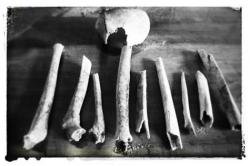 Saint François – En janvier 2013, suite à des pluies diluviennes, les médias informaient de la « découverte » d’un cimetière d’esclaves, en Guadeloupe, sur la plage des Raisins Clairs de la commune de Saint-François. Les journaux nous annonçaient , à l’époque, une campagne de fouilles archéologiques sur un site exceptionnel, à l’échelle de la Caraïbe tout entière, pour la connaissance de l’histoire de l’esclavage aux Amériques. En ce mois de mai, mois de la mémoire, les os des esclaves, aïeux d’un grand nombre d’entre nous, sont laissés là, à même le sable, sans aucune protection contre les éléments naturels, la pollution, l’ignorance des baigneurs et dans le désintérêt collectif.
Saint François – En janvier 2013, suite à des pluies diluviennes, les médias informaient de la « découverte » d’un cimetière d’esclaves, en Guadeloupe, sur la plage des Raisins Clairs de la commune de Saint-François. Les journaux nous annonçaient , à l’époque, une campagne de fouilles archéologiques sur un site exceptionnel, à l’échelle de la Caraïbe tout entière, pour la connaissance de l’histoire de l’esclavage aux Amériques. En ce mois de mai, mois de la mémoire, les os des esclaves, aïeux d’un grand nombre d’entre nous, sont laissés là, à même le sable, sans aucune protection contre les éléments naturels, la pollution, l’ignorance des baigneurs et dans le désintérêt collectif.
http://blogs.mediapart.fr/blog/lidejis/050613/honte-et-tristesse-guadeloupe-31-mai-2013
ROYAUME UNI – 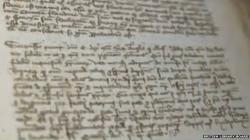 Bannockburn - A copy of an unknown Robert the Bruce letter from the build-up to the Battle of Bannockburn has been discovered. The letter, sent in 1310, asks English King Edward II to stop persecuting the Scots. It shows Robert asserting his God-given authority as king of the Scots and addressing Edward as his equal. The script, thought to have been transcribed from the original, was discovered by chance by a professor of Scottish history at Glasgow University. Bruce's Scottish troops defeated the English army at the Battle of Bannockburn in 1314. By the time of the Battle of Bannockburn in 1314, Bruce had taken all the strongholds except Stirling and those near the English border. In the end, Bruce's move in 1310 paid off as King Edward took his army south again to Berwick where he remained until July the next year. The next time he returned north, three years later, Edward was beaten at Bannockburn.
Bannockburn - A copy of an unknown Robert the Bruce letter from the build-up to the Battle of Bannockburn has been discovered. The letter, sent in 1310, asks English King Edward II to stop persecuting the Scots. It shows Robert asserting his God-given authority as king of the Scots and addressing Edward as his equal. The script, thought to have been transcribed from the original, was discovered by chance by a professor of Scottish history at Glasgow University. Bruce's Scottish troops defeated the English army at the Battle of Bannockburn in 1314. By the time of the Battle of Bannockburn in 1314, Bruce had taken all the strongholds except Stirling and those near the English border. In the end, Bruce's move in 1310 paid off as King Edward took his army south again to Berwick where he remained until July the next year. The next time he returned north, three years later, Edward was beaten at Bannockburn.
http://www.bbc.co.uk/news/uk-scotland-tayside-central-22734279